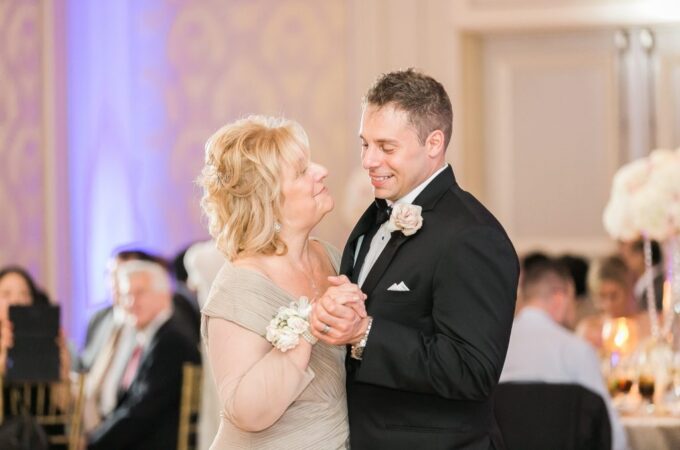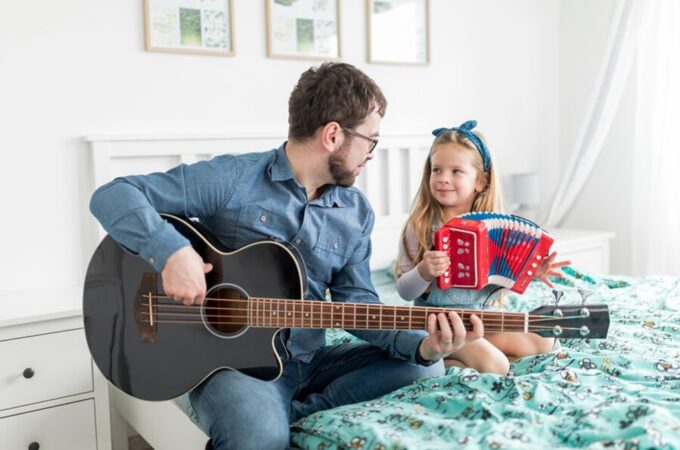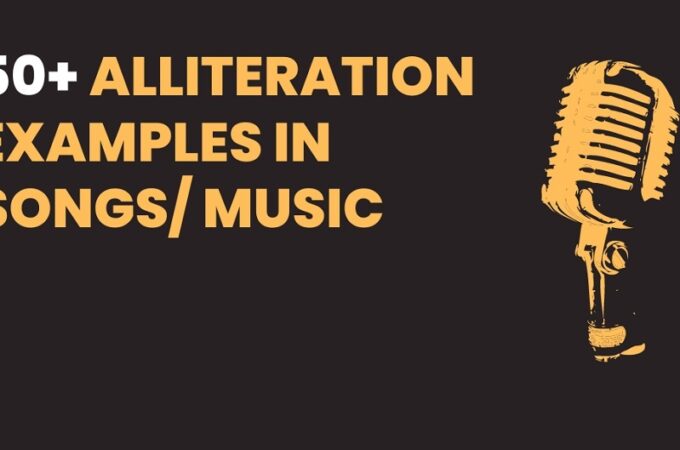
Easy Violin Songs to Play for Beginners
Learning to play the violin can be an immensely rewarding experience. The violin produces a beautiful, singing tone that allows players to express a wide range of emotions in their music. However, it does take time and practice to develop good violin technique. As a beginner, it’s important to start with easy violin music to help build up skills without becoming discouraged. Here’s an in-depth look at some of the best easy violin songs for beginners to try.
Table of Contents
ToggleWhy Start with Easy Violin Songs?
When you’re just starting to learn the violin, it’s tempting to try and jump right into playing advanced classical pieces. However, harder violin music requires skills like shifting between high positions, complex bow techniques, and quick finger movements that take time to develop. Attempting difficult violin songs too early can end up being frustrating, as you struggle to get clear notes and maintain rhythm.
On the other hand, easy violin songs for beginners are designed to introduce basic violin techniques step-by-step. The fingerings stay in first position, the notes move slowly, and the rhythms are straightforward. This allows you to focus on proper posture, holding the bow correctly, and getting a good tone. Mastering easier violin music helps build up the muscle memory and ear training necessary to tackle more advanced repertoire down the road.
Starting with simple violin songs also helps keep motivation high in the early stages. You’ll gain confidence as you successfully play through whole melodies, instead of just isolated notes and exercises. Easy violin pop songs, movie themes, folk tunes, and classical pieces all make excellent starter songs for new violinists.
Tips for Learning Easy Violin Music
When you begin practicing easy violin music, keep these tips in mind:
- Go slowly – For each new song, start by going through it measure by measure at a very slow tempo. Repeat difficult sections until you can play them comfortably. Then gradually increase the speed. Don’t rush – it’s better to play slowly and accurately.
- Pay attention to intonation – Make sure you’re placing your fingers precisely on the correct notes. Listen closely and adjust any notes that sound out of tune. Good intonation is important even for easy violin songs.
- Note rhythm – Counting out loud can help lock in the rhythm. If there are tricky syncopations or ties, isolate and repeat those measures to ingrain the rhythm.
- Relax your body – Avoid tension in your neck, shoulders, and hands. Staying relaxed will produce a better tone and let you play more fluidly.
- Watch your bow – Keep your bow strokes straight and smooth. For trickier bow distributions, break them down and practice just the bowing at first.
- Work up to playing the full song – Once you can comfortably play each section, start linking them together to perform the complete piece.
Now let’s look at some of the best easy violin songs for beginners across different genres…
Easy Classical Violin Songs
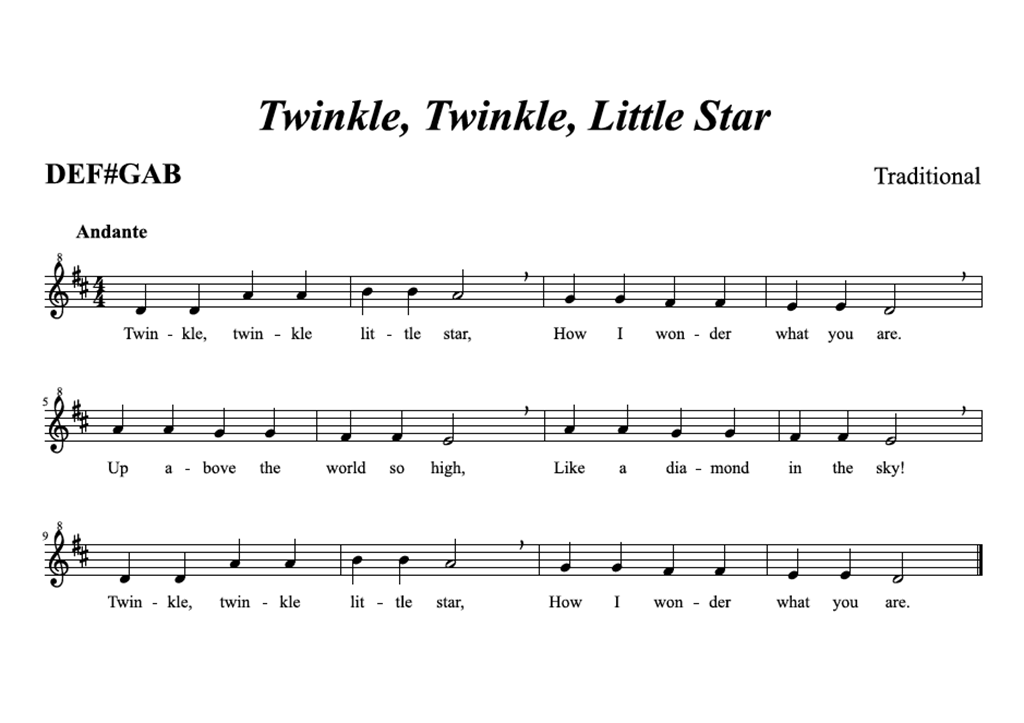
Classical music written specifically for beginner violinists will help develop good technical skills. Here are some easy classical violin songs to explore:
Suzuki Violin School Pieces
The Suzuki Method books contain many excellent classical pieces for violin beginners. These include:
- Twinkle, Twinkle, Little Star – The famous children’s lullaby arranged for violin. Focuses on string crosses and light detaché bowing.
- Lightly Row – Another easy folk tune. Practices legato bow strokes and gradual dynamic changes.
- Song of the Wind – A simple Japanese folk song. Great for practicing consistent bow pressure and smooth string changes.
- Go Tell Aunt Rhody – This American folk song is in a major key and has a upbeat, rhythmic feel.
Wohlfahrt Etudes
These 60 progressive etudes by German composer Franz Wohlfahrt cover skills like shifts, dynamics, accidentals, slurs, and syncopation. The first 15 are suitable for beginners. Good ones to try are:
- Etude No. 4 – Focuses on legato bowing and smooth lower string changes.
- Etude No. 7 – Introduces slurs over two notes and some simple syncopation.
- Etude No. 9 – Practices legato detache strokes across all four strings.
Tunes from Method Books
Violin method books also include many elementary classical pieces. Some examples:
- Long, Long Ago – A basic melody using quarter and half notes. Found in the Essential Elements method.
- March of the Little Soldiers – Upbeat staccato march from the All for Strings book.
- Lullaby – Sweet, lyrical piece practicing legato bows. From the Violin School books.
- May Song – Bouncy tune with pizzicato notes. Appears in String Explorer.
Easy Violin Hymns
Simple, well-known hymns make great practice songs for beginning violinists. Here are some easy violin hymns to try:
- Amazing Grace – Very simple; uses open strings and repetitive finger patterns.
- What a Friend We Have in Jesus – Straightforward; focuses on bow distribution.
- Be Thou My Vision – Melodic; all notes are in first position.
- Come, Thou Fount of Every Blessing – Flowing and lyrical; stresses legato.
- For the Beauty of the Earth – Softer dynamic range; repetitive fingering.
- It Is Well With My Soul – Smooth and stepwise; light detaché strokes.
Easy Violin Christmas Songs
The holiday season offers lots of opportunities to play festive violin music. These Christmas songs are easy to learn on violin:
- Jingle Bells – Very recognizable, mostly plays open strings.
- Silent Night – Beautiful and peaceful; practices legato bowing.
- Deck the Halls – Jaunty and upbeat; focuses on string crosses.
- Joy to the World – Powerful melody using strong detached bows.
- O Come, All Ye Faithful – Grand and lyrical; uses slurs and legato.
- We Wish You a Merry Christmas – Cheerful classic with staccato notes.
Easy Violin Pop Songs
Contemporary pop tunes arranged for beginner violinists make it fun to practice playing melodies and rhythms. Here are some easy pop violin songs:
- Let It Be (The Beatles) – Iconic melody; strong legato theme.
- Imagine (John Lennon) – Smoothly flows across strings; simple rhythm.
- Roar (Katy Perry) – Great for practicing detached bowing; very motivational!
- Hey, Soul Sister (Train) – Catchy syncopated rhythms; upbeat.
- Stay (Rihanna) – Beautiful sweeping melody line.
- Count On Me (Bruno Mars) – Sweet, lilting song with stepwise notes.
Easy Violin Movie Themes
Recognizable melodies from favorite movie and TV soundtracks also work nicely for violin beginners. For example:
- Hedwig’s Theme (Harry Potter) – Quick legato runs; light and magical sounding.
- My Heart Will Go On (Titanic) – Powerful cello-like solo; emotional sweeping melody.
- Over the Rainbow (Wizard of Oz) – Gentle accompaniment lets melody shine.
- The Pink Panther – Fun, sneaky tune; practices staccato.
- Star Wars Theme – Bold and heroic; strong detached bowing.
- James Bond Theme – Driving repeated rhythm patterns.
Easy Fiddle Tunes
The violin and fiddle are the same instrument, but fiddle music has more of a folk feel. These are some easy fiddle tunes for beginners:
- Boil Them Cabbage Down – Fast-paced; focuses on steady eighth notes.
- Turkey in the Straw – Lively; slurs over repeated notes.
- Liberty – Patriotic; marcato dotted rhythms.
- Angeline the Baker – Celtic jig in 6/8 time.
- Arkansas Traveler – Classic country; syncopated rhythms.
- Red River Valley – Sweet, flowing cowboy ballad.
Tips for Finding More Easy Violin Music
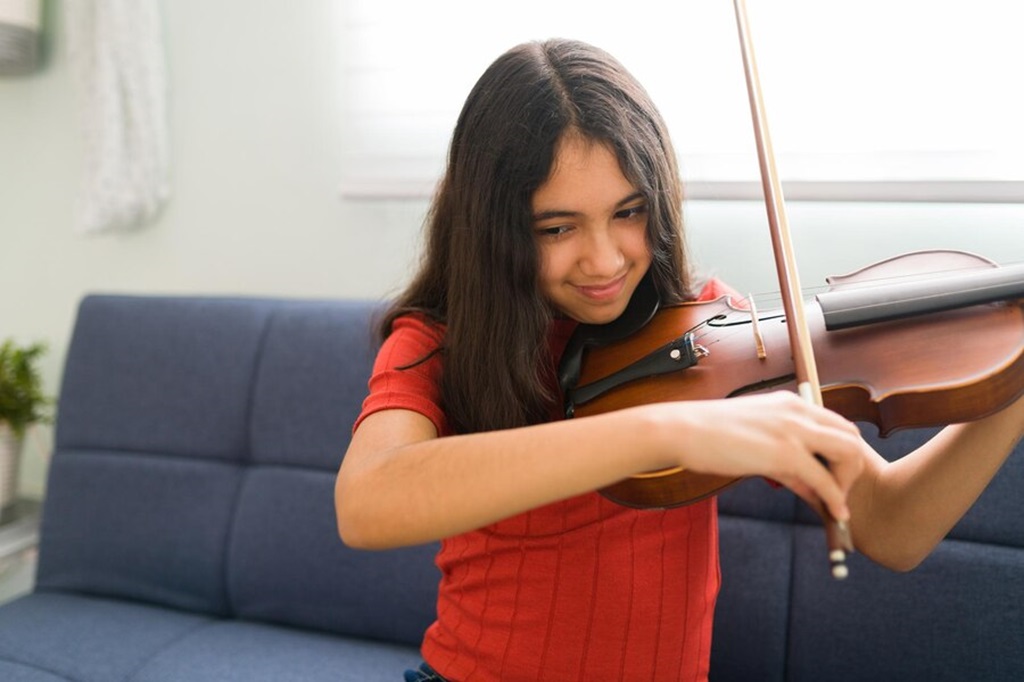
- Look for violin pieces listed around the Suzuki Violin School Vol. 1 level. These use basic bowing patterns and first finger position.
- Try beginning violin method books like Essential Elements, All for Strings, and String Explorer. They contain numerous elementary violin pieces to practice.
- Listen to violin beginner albums – these feature professional recordings of easy violin music. The Suzuki Violin School CDs are a great option.
- Search for “beginner violin sheet music” online. There are many websites offering free printable easy violin music. Be sure to preview before downloading.
- Watch beginner violin tutorials on YouTube to get new song ideas. Many violinists demonstrate easy arrangements.
- Ask your violin instructor for recommendations on easy classical, folk, fiddle, pop, movie, or holiday songs to supplement method book pieces.
Common Problems When Starting Violin
Learning to play the violin can be challenging at first. But armed with patience and the right guidance, these common problems faced by beginners can be overcome:
Problem: Violin Hold and Posture Issues
Good posture is crucial when playing the violin in order to hold the instrument properly and draw the bow across strings. Common problems involve tightness, slouching, and improper head positioning:
- Try to stay relaxed rather than tense. Adjust violin height and shoulder rest to find a comfortable position.
- Don’t hunch over. Keep back straight, chest open, and hips even. This allows you to draw the bow freely.
- Hold head straight without tilting. Look slightly left when playing to see your fingers on the fingerboard.
Problem: Left Hand and Finger Tension
It takes time to develop finger independence and strength on the violin fingerboard. Be patient and avoid “squeezing” the neck, which leads to tension:
- Use just enough pressure to sound notes clearly without pressing too hard.
- Keep knuckles rounded and fingers curved as if holding a ball.
- Take fingers off the string completely to reset when changing notes.
- Stretch and shake out the left hand to release tension.
Problem: Difficulty Placing Fingers in Tune
Mastering clean intonation is an ongoing process for violinists. But these tips will help improve tuning accuracy:
- Listen carefully and use ear training apps to hone intonation.
- Make sure you’re placing fingers precisely on the correct spot for each note.
- Use reference points like the tapes on the fingerboard to guide hand position.
- Let fingers fall naturally – don’t reach or overextend.
Problem: Bow Hold Problems
The bow hold affects tone production and control. Common beginner issues include cramped hands, collapsing joints, and excessive tension:
- Keep bow hand rounded like holding a ping pong ball, not flat and tense.
- Don’t let knuckles collapse. Keep wrist and fingers curved.
- Use just enough pressure to get a steady, clear tone without squeezing the bow.
- Make sure thumb is bent and on the corner of the frog.
Problem: Poor Bow Control
It takes coordination to smoothly draw the bow across strings at the correct angle. Be patient as you develop this skill:
- Start with slow, full bow strokes. Use the whole bow rather than just the middle.
- Keep wrist flexible and elbow raised so bow can move parallel to the bridge.
- Use a mirror to check that bow is perpendicular to strings, not tilted up or down.
- Focus on steady, light pressure and straight bow direction.
Problem: Difficulty Producing Good Tone
Beginners often press too hard while bowing, resulting in crunchy tones. Or their bow strokes aren’t smooth, creating scratchy sounds.
- Bow closer to the bridge to produce clearer, more resonant notes.
- Relax the bow grip and use your arm weight, not just hand muscles.
- Draw the bow slowly and straight. Too much speed or angles makes tone suffer.
- Listen closely and adjust pressure and contact point until tone is clear and sings.
How to Practice Violin as a Beginner
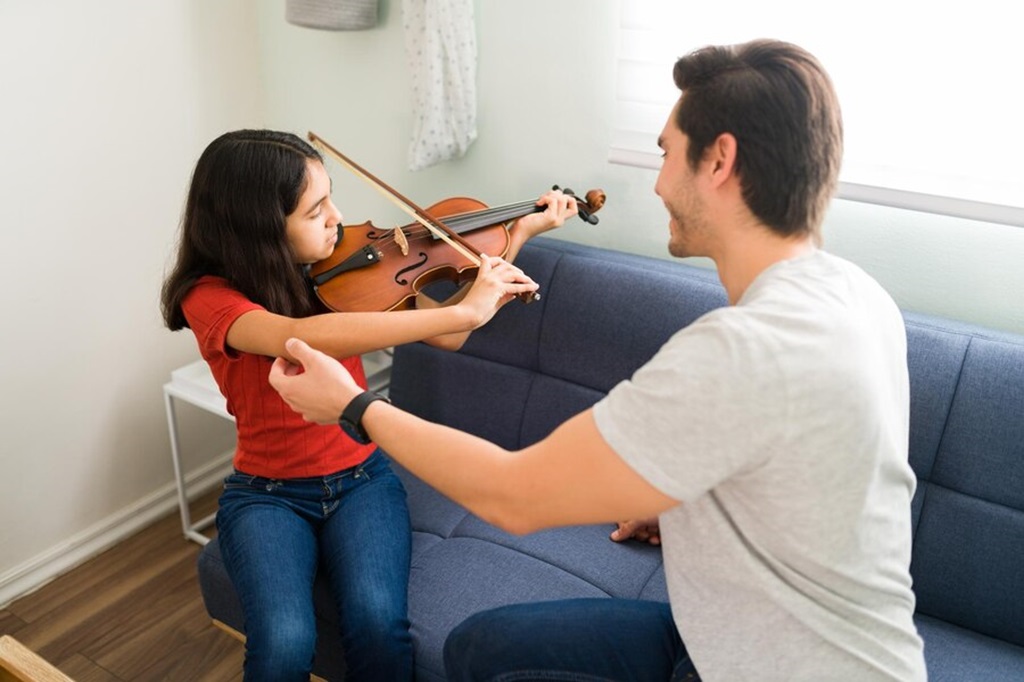
To advance your violin skills, you need to incorporate regular, focused practice sessions. Here are some tips for productive violin practicing as a beginner:
Set Aside Consistent Practice Time
- Aim to practice at least 15 minutes daily, working up to 30-45 minutes. Consistency is key.
- Schedule practice for a time you can stick to daily – first thing in the morning works for many.
- Only sit down to practice when you can fully focus for the allotted time to avoid unproductive sessions.
Follow a Routine
- Structure each practice session so you’re not just playing randomly. This helps instill good habits.
- Warm up with scales, arpeggios or open string exercises to limber up.
- Work on 1-2 technique skills like bow strokes, shifting, pizzicato, etc.
- Practice current repertoire pieces. Isolate tricky sections and take them slowly.
- End with “fun” improvisation or a new piece you’re exploring.
Eliminate Distractions
- Turn off devices and TV. Close other tabs. Don’t practice where you’ll be interrupted.
- Set a timer so you’re not tempted to check the clock. Apps like Insight Timer are great for this.
- Isolate tricky parts by practicing difficult measures alone. Don’t just keep playing through whole pieces.
- Focus fully when practicing. Don’t multitask. Active listening is key.
Use a Metronome
- Use a metronome app set to an appropriate tempo for each piece. This develops solid rhythm.
- Gradually increase the metronome speed only after you can play a section perfectly at the slower tempo.
- Practice with a metronome even when not working on a specific piece to improve timing.
Break Down Tough Spots
- When you come to a difficult spot, slow it way down and practice just that part, not the whole piece.
- Once the tricky section is mastered slowly, start incorporating it back into playing the full song at tempo.
- Repeat difficult parts until they are comfortable. Muscle memory comes from targeted repetition.
- Stay relaxed and patient. Learning takes time.
Record Yourself
- Use your phone to video record yourself periodically as you practice pieces. Watch these back to self-critique.
- Recording helps you hear objectively and spot things like intonation issues, tense posture, etc.
- You can also record the main melodies and watch your finger placement on slo-mo.
Make Efficient Use of Practice Time
- Don’t waste time just “playing through” easy songs. Prioritize challenging areas that require focused repetition.
- Jot down specific trouble spots in each piece and zero in on these spots first when practicing that song.
- Talk through your practice goals out loud at the start of each session to stay on track.
How to Develop Good Violin Technique
While playing easy violin music helps build a foundation, you’ll also need to spend time honing proper violin technique. Good technique gives you the tools to progress to more advanced repertoire.
Here are some of the main violin techniques for beginners to focus on developing:
Bow Technique
- Straight bow – Keep the bow traveling straight across the strings, not bouncing or drifting up/down.
- Full bow strokes – Use the entire length of the bow rather than just the middle.
- Bow distribution – Practice moving from string to string smoothly.
- Tone production – Draw the bow slowly and lightly at first, listening for crisp tone.
- Bow lifts – Lift the bow as you change notes so each starts with a fresh stroke.
- Hooked bowing – Play repeated down bows at the frog and hooked up bows near the tip.
Left Hand Technique
- Relaxation – Avoid squeezing neck or pressing too hard. Use just enough finger pressure to sound notes.
- Intonation – Listen closely to develop accurate tuning on all fingers. Check against open strings.
- Finger independence – Lift each finger high as you place the next to keep separation. Don’t cram.
- Shifting – Learn to smoothly slide hand up and down while keeping frame stable.
- Vibrato – For an expressive wavering sound.
- Trills – Quickly alternating between two fingers on nearby notes.
Reading Music
- Note names – Know which note on the staff corresponds with which string/finger.
- Rhythm – Understand counting rhythms in simple and compound meter. Subdivide beats.
- Musical symbols – Recognize markings for dynamics, articulation, repeats, accidentals, etc.
- Fingerings – Follow given finger numbers and placement. Pay attention to shifts.
Listening Skills
- Matching pitch – Play notes matching pitch of open strings, tuner, or piano.
- Dynamics – Listen and respond to volume levels – p (piano), f (forte) etc.
- Timbre – Adjust bow speed, weight and position to refine tone color.
- Intonation – Use ear to actively listen and adjust notes that sound out of tune.
How to Read Violin Sheet Music
Learning to read violin sheet music is an essential skill. Here are some tips to help you make sense of violin notes, rhythm, key signatures, and other musical markings when first starting out:
The Violin Clef
- Violin music is written in the G clef, which wraps around the G line on the staff.
- Notes on the lines correspond to these strings/fingers: G=G string/4, B=A string/3, D=D string/2, F=A string/1.
- Notes in the spaces correspond to these strings/fingers: A=A string/open, C=D string/1, E=A string/2.
Note Values
- A quarter note gets one beat, half note gets two beats, whole note gets four beats. Dotted notes are extended.
- Flags on stems indicate beam groups in faster rhythms. Beams connect eighth and sixteenth notes.
- Listen to the rhythm and subdivide the beat to count properly. Understand time signatures too.
Sharps, Flats and Naturals
- The key signature after the clef shows which notes are sharpened or flattened throughout the piece.
- Accidentals (♯ ♭ ♮) placed before a note temporarily alter it for that single measure.
- Make sure you pay attention to accidentals and play the correct notes – don’t rely just on finger position.
Articulation and Style Markings
- Symbols convey how to perform notes:
- Slurs (curved lines) – Play legato or smoothly connected.
- Staccato dots – Short detached notes.
- Accents – Play strongly emphasized.
- Other markings give stylistic instructions:
- Tempo and metronome markings
- Expression and dynamic marks like p (soft), f (loud)
- Performance instructions like ritardando, a tempo, etc.
Bowing and Fingering
- Arrows above or below notes show direction of bow strokes up or down.
- Numbers by notes tell which finger to use – 1 = index, 2 = middle, etc.
- Follow fingerings carefully, watching for shifts between positions.
Practice Reading Slowly
- Read music at a very slow tempo until noting sequences gets comfortable.
- Scan ahead to see what’s coming next. Eventually you’ll read groups of notes together.
- If completely new to reading music, start by recognizing notes on open strings before tackling fingered notes.
- Use beginner music books and downloads to find simple sheet music to practice reading before tackling advanced pieces.
Using Technology Tools to Enhance Violin Practice
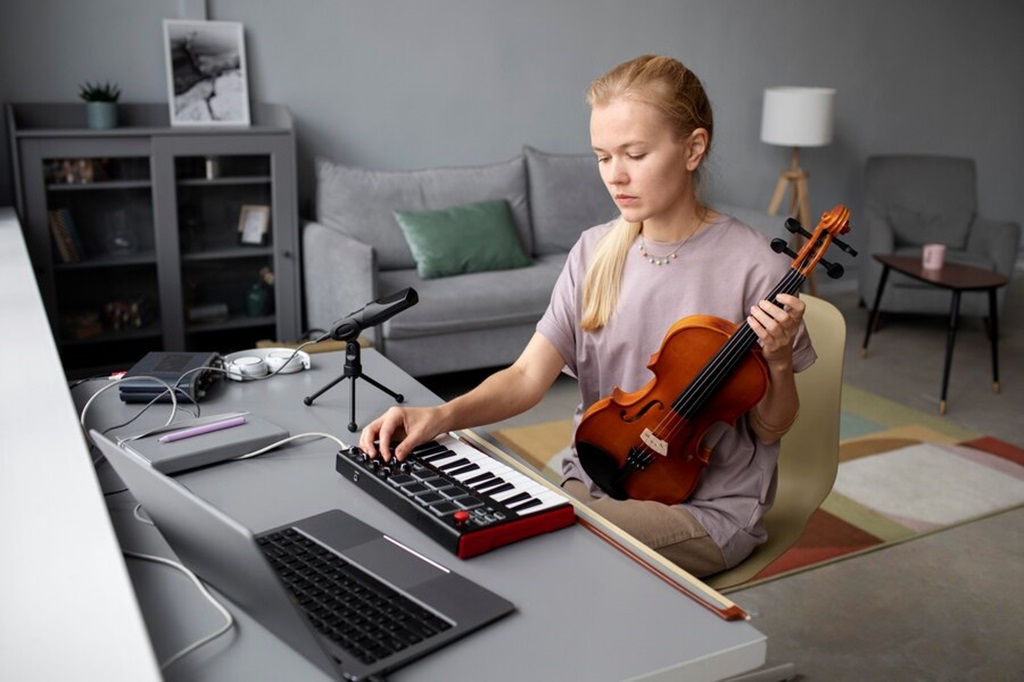
Today’s technology offers useful tools to help motivate and track violin practice. Here are some apps and devices for beginners to try:
Metronome Apps
Metronome apps provide steady beats to help ingrain rhythm and timing. Options like Tempo, Time Guru, and Tonal Energy are very customizable for tempo, meter, accents, etc.
Tuner Apps
Tuner apps use your phone’s mic to detect pitch. Checking tuning against them develops your ear. Some popular ones are ClearTune, Pano Tuner, String Tuner, and PitchLab.
Sheet Music Apps
Apps like Musicnotes, forScore, and Newzik provide digital sheet music you can annotate and take anywhere. Many also include tempo adjustment, recording tools, and playback.
Playback Apps
Slow down tricky parts and play along with accompaniment using apps like The Amazing Slow Downer, Anytune, and Capo. Looping sections is helpful for practice.
Instructional Apps
Get lessons and tutorials right on your phone or tablet with apps like Violin Academy, Fiddle Hangout, Pocket Violin Tutor, and Violin Lab. Many are aimed at beginners.
Digital Recorders
Pocket handheld recorders like the Zoom H1n allow you to record practices to review your progress. Hear your tone and catch things to improve.
Smart Music Studio Tools
Devices like the SmartMusic system use mics, AI technology, and games to provide real-time feedback on notes, rhythm, and technique as you play along with background tracks.
Have Fun Learning with Technology
The world of educational tech tools keeps expanding. Take advantage of new innovations to get motivated, practice more consistently, hone skills, and track your improvement as a beginning violinist!
Developing Good Practice Habits
The key to improving as a violinist is developing effective practice habits. Here are some characteristics of productive, skill-building practice sessions:
Be Focused
- Set specific goals for each session and avoid distractions. Pay close attention to your playing.
- Know which skills and spots in repertoire you want to focus on before you start. Time will be used more efficiently.
- Mentally prepare to concentrate fully on deliberate practice for the whole session. No multitasking.
Stand Analytical
- Don’t just play pieces through – isolate and problem solve tricky sections.
- Analyze and think critically about your technique. Notice tension or errors and self-correct.
- Record yourself periodically so can hear objectively and identify areas needing attention.
Be Patient
- Learning an instrument takes time and repetitive practice. Stick with difficult spots.
- Increase tempo and expectations gradually. Understanding comes before speed.
- Don’t let frustration lead to shortcuts. Stay relaxed and keep trying till you succeed. Then build on it.
Live Consistent
- Frequent short practices of 15-30 minutes are best for establishing skills, rather than infrequent long sessions.
- Schedule practice as part of your regular routine like brushing your teeth, not just when you feel inspired.
- Repetition over time ingrains muscle memory. Sporadic practice leads to forgetting and backsliding.
Stay Positive
- Be encouraging toward yourself. Celebrate achievements.
- Focus on sounding and feeling better over time, not perfection. Progress will keep you motivated.
- If bored with pieces, mix up your routine or find new music. Curiosity fuels learning.
Good practice habits pave the way for enjoyable progress as a beginner violinist!
How to Care for Your Violin
Investing in your first violin is exciting! Learn how to properly care for your instrument so it stays in top playing condition:
Case Use
- Keep violin in case when not playing to avoid damage from bumps or temperature/humidity fluctuations.
- Lay case flat and avoid placing heavy objects on top that could press on instrument.
- Store music, shoulder rest, and accessories neatly in case compartments to avoid rattling around during transport.
Regular Tuning
- Tune violin every time before playing, using the pegs or fine tuners. Apps make tuning easy.
- Replace strings as soon as tone quality declines or they won’t hold pitch. Old strings inhibit proper learning.
- Have new violins professionally set up, including fitting the bridge and soundpost.
Proper Handling
- Always grip violin firmly by neck and body when lifting out of case. Never just the neck!
- Don’t over-tighten or leave pressure on bow when in case, as it can warp the stick.
- Loosen bow before putting away and clean rosin dust off strings/instrument after playing.
- Avoid temperature or humidity extremes. Never leave instrument in hot or cold car.
Prevent Physical Damage
- Don’t let violin fall or collide with other objects. Watch out for chair legs, stands, etc.
- Keep tissues handy to wipe off fingerprints and rosin dust after practicing.
- Don’t touch the varnish unnecessarily. Skin oils wear down the finish over time.
Routine Maintenance
- Take violin to luthier yearly for new strings, bridge adjustment, and general inspection of body condition.
- Mark instrument discreetly with ID in case of loss or theft.
Caring for your violin properly ensures it will last many years and retain its tone. Be gentle, keep it clean, and handle with care!
Tips for Buying Your First Violin
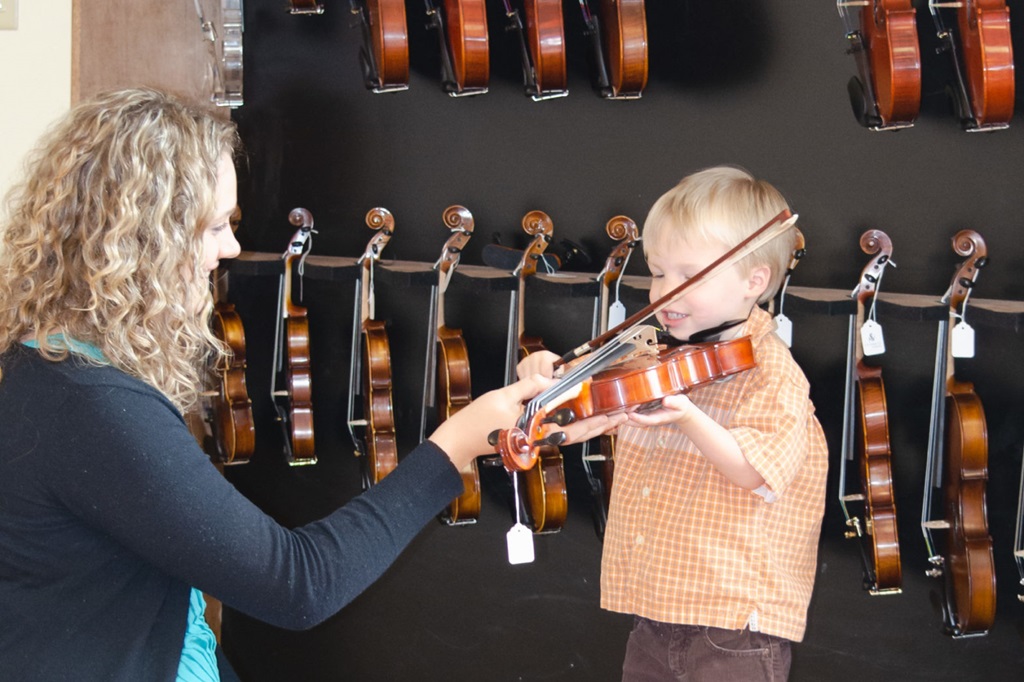
Purchasing your first violin is exciting but it’s important to get good value for your budget. Here are tips for beginners on finding the right starter violin:
Consider Renting First
Many music stores offer rent-to-own programs that let you apply rental fees towards buying the violin. This allows you to try out an instrument without full commitment.
Get a Teacher Recommendation
Ask your violin instructor for advice on brands, sizes, and stores to check for quality student instruments in your price range. Their guidance is invaluable.
Try Before You Buy
Test violins in person and listen to the tone quality. Judge comfort too – does it feel balanced under your chin and not too large?
Prioritize Playability
For beginners, focus on getting a violin that plays well and sounds decent first. You can upgrade to a more beautiful instrument later as skills improve.
Avoid Ultra Cheap Violins
Very low-priced violins often come unplayable “out of the box” and can’t be tuned properly. Better to spend a bit more for adequate quality.
Consider Outfit Packages
Starter violin outfits include everything needed – case, bow, rosin – for one price. This prevents having to buy these items separately.
Inspect Thoroughly
Examine violins closely yourself and ask questions. Check for cracks, warping, worn pegs, etc. Have a teacher help assess potential issues.
Get a Proper Setup
After purchase, immediately get a professional setup done on the violin – this optimizes playability.
Choose your first violin wisely and it will serve you well as you progress! Let your teacher guide the process for the best outcome.
Last Words
The journey of learning to play with easy violin songs the violin can be incredibly fulfilling, but it’s no secret that it comes with its fair share of obstacles. In the beginning, it may seem daunting and frustrating, but with unwavering dedication and a healthy dose of patience, you will undoubtedly see significant progress over time. It’s important to remember to trust the process, to not get too caught up in the end goal, and to focus on celebrating your small accomplishments along the way. Above all, remember to cherish the experience of creating music and the joy that comes with it.
FAQs
- How long does it take to be able to play violin reasonably well as a beginner?
It varies for each student based on factors like age, practice consistency, musical experience, aptitude, etc.
- What is the best age to start learning violin?
You can begin violin at any age! However, starting as a young child around ages 3-5 is ideal. Very young children can learn good habits immediately and their flexibility aids posture.
- How do I know what size violin to get as a beginner?
Consult your violin teacher for the best size recommendations based on your age and arm length. Children often start on fractional size violins like 1/16, 1/10, 1/8, 1/4. Teens may use 1/2 or 3/4 size before moving up to a full 4/4 violin.
- What violin accessories do I need when starting out?
Essential beginner violin accessories include: violin shoulder rest, extra set of strings, violin stand, music stand, cleaning cloth, hygrometer (to monitor humidity), metronome/tuner, and pencil.
- Should I get private violin lessons or can I learn violin on my own as a beginner?
Private lessons are strongly recommended when starting violin, especially for children. A good teacher will ensure you establish proper technique and practice habits in the early stages, preventing issues.

